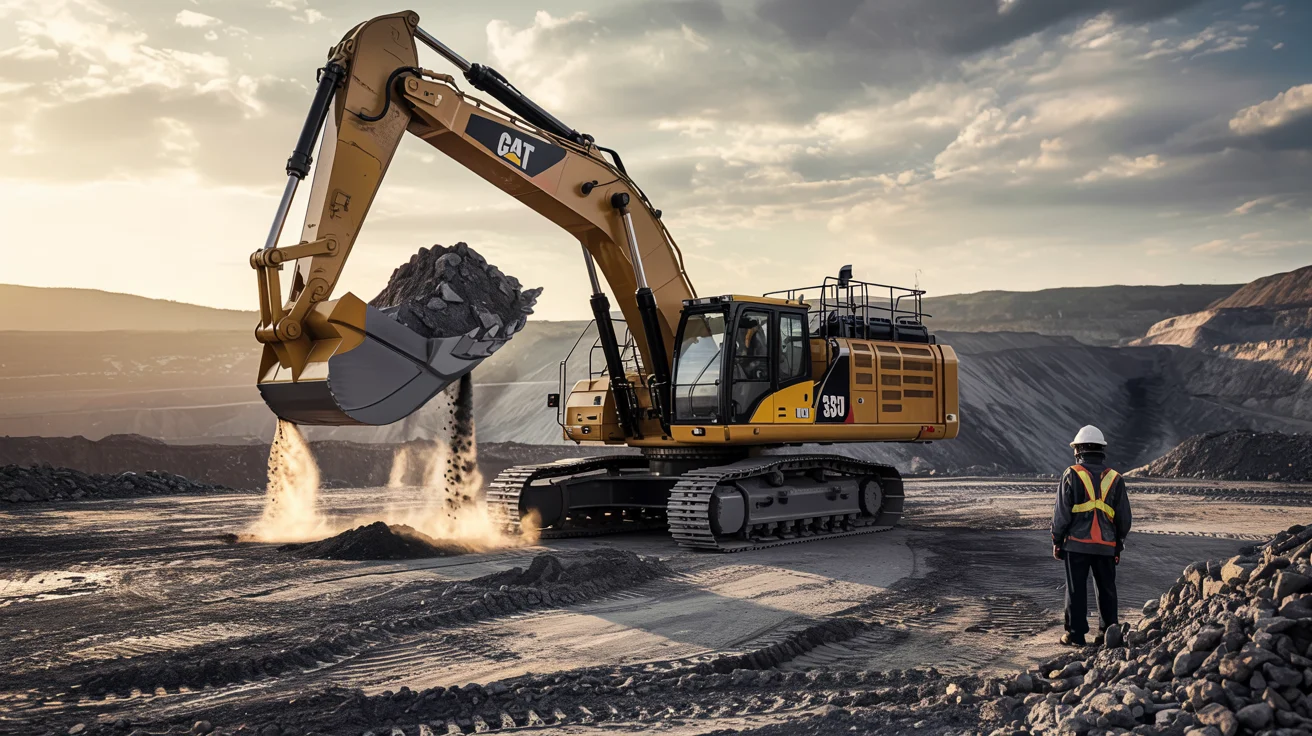11 Excavator Types & Uses – Size Guide
In high-stakes construction, the wrong excavator can stall timelines and spike operating costs. From compact mini excavators to large hydraulic and long-reach models, each excavator type offers unique advantages in depth, swing radius, reach, and lifting power.
This guide is built for contractors, civil engineers, and equipment managers who need precision in machine selection. With a focus on lift specs, terrain compatibility, and attachment options, we’ll break down excavator types so you can match machine to mission—and move more earth, faster.
There are six main types of excavators: crawler, dragline, suction, skid steer, long reach, and wheel. Crawler excavators are best for rough terrain. Dragline excavators handle underwater projects. Suction models clear debris with high-pressure vacuuming. Each type suits specific construction or excavation needs.
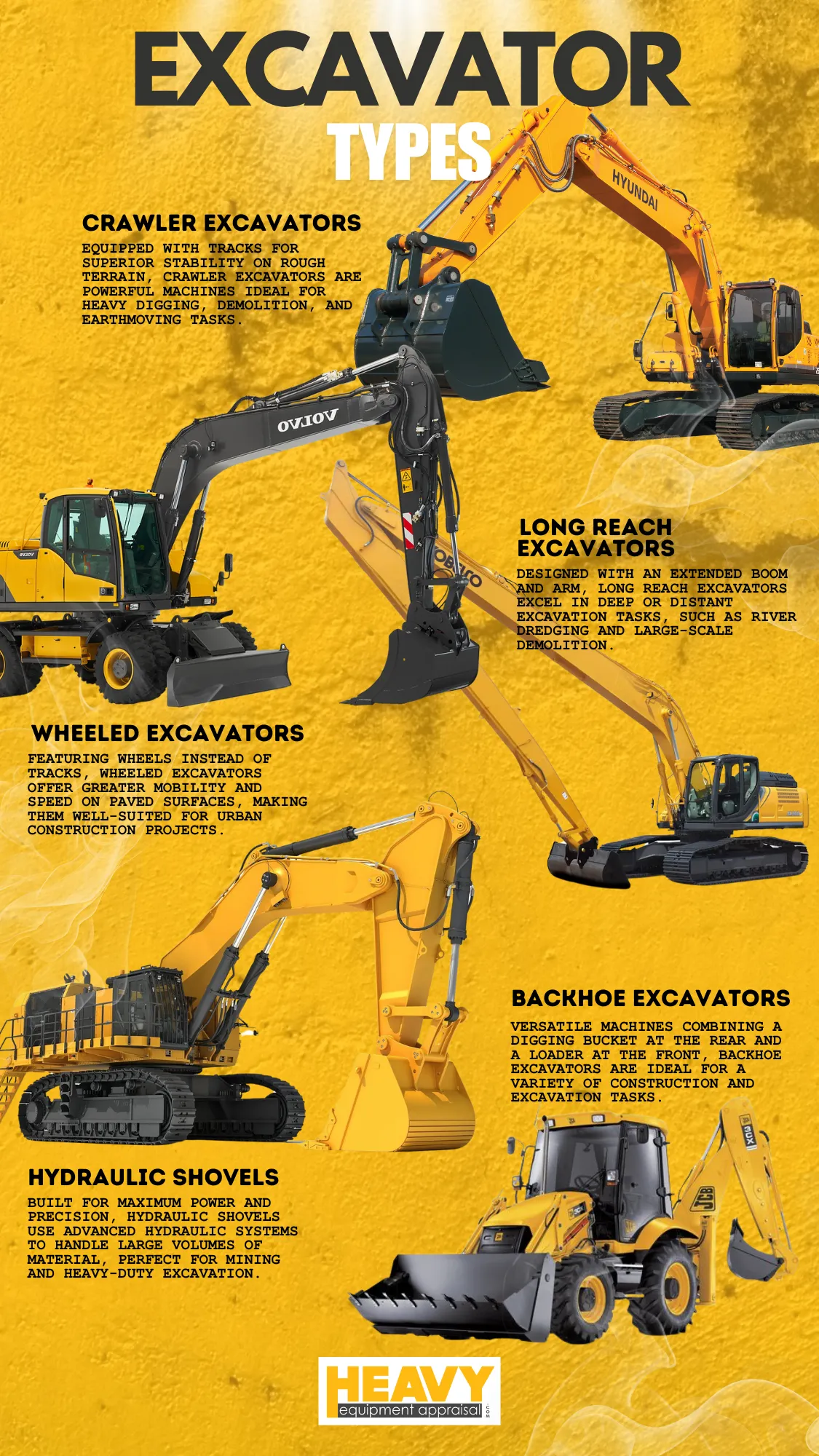
What Makes Modern Excavators So Capable?
Today’s excavators are a far cry from the old cable-operated machines that preceded them. At their core, excavators consist of three main components:
- Undercarriage: The tracked or wheeled base that keeps the machine stable and mobile, complete with final drives, rollers, and sometimes a front blade for light grading.
- House: The rotating upper structure containing the operator’s cab, engine, hydraulic components, and counterweight. That full 360° rotation capability? That comes from the swivel joint connecting the house to the undercarriage.
- Arm Assembly: The business end, consisting of the boom (the long arm attached to the house), the stick (connecting to the boom), and the bucket type (or whatever attachment you’ve got mounted).
What truly transformed these machines was the shift to hydraulics. When manufacturers replaced mechanical cables with hydraulic cylinders and motors, it opened up a world of possibilities. Those 5,000 psi hydraulic systems deliver precise control while maintaining the raw power needed to rip through compacted soil or lift massive pipes.
Finding Your Perfect Match: Excavator Categories Explained
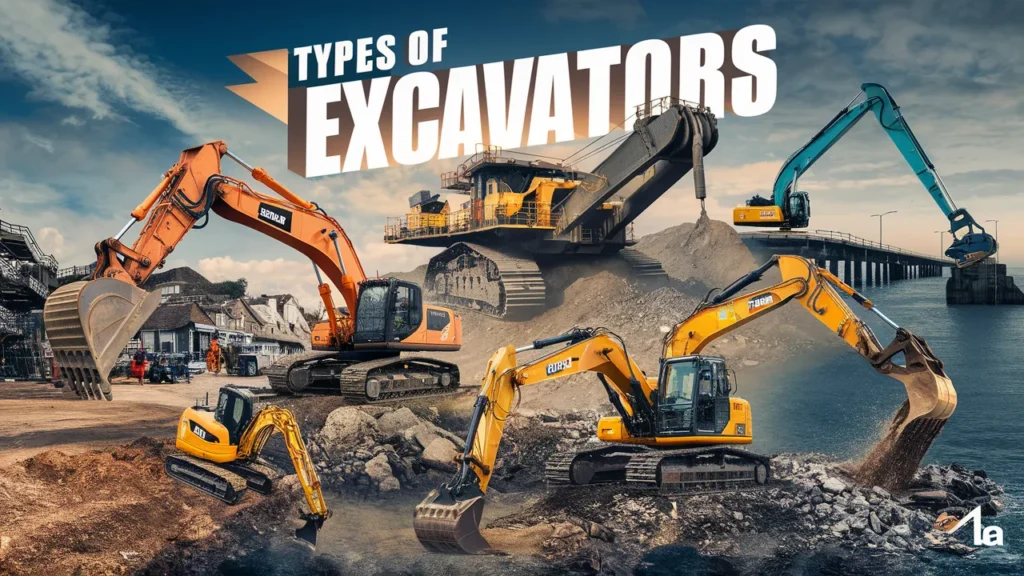
Excavators aren’t one-size-fits-all, and size definitely matters. Here’s how they break down:
By Size
Excavator sizes are classified as mini (0–6 tons), medium AKA “midi” (6–10 tons), and large (10–90+ tons). Mini excavators are used for light-duty tasks in tight spaces, medium sizes suit general construction, and large excavators handle heavy-duty work like mining or major earthmoving.
Mini/Compact Excavators

Mini/Compact Excavators (under 10 metric tons): These nimble machines excel in tight spaces – think residential work, landscaping, and utility installation. Many feature zero tail swing, allowing them to rotate within their track width.
Midi Excavators
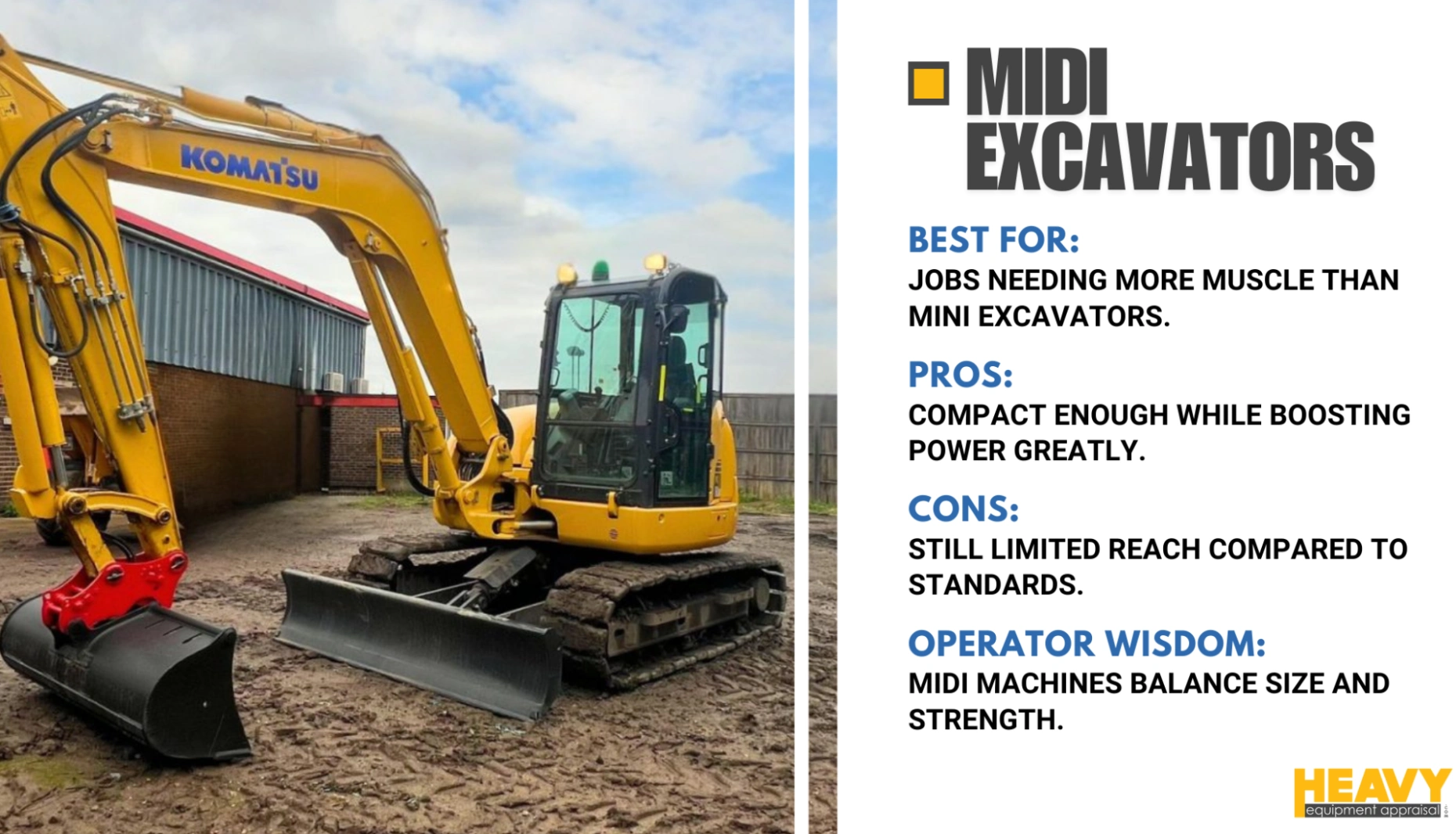
Midi Excavators (6-10 metric tons): The “goldilocks” machines that bridge the gap between minis and standard excavators.
Standard/Medium Excavators

Standard/Medium Excavators (10-45 metric tons): The versatile workhorses you’ll see on most construction sites, handling everything from foundation excavation to material loading.
Large Excavators
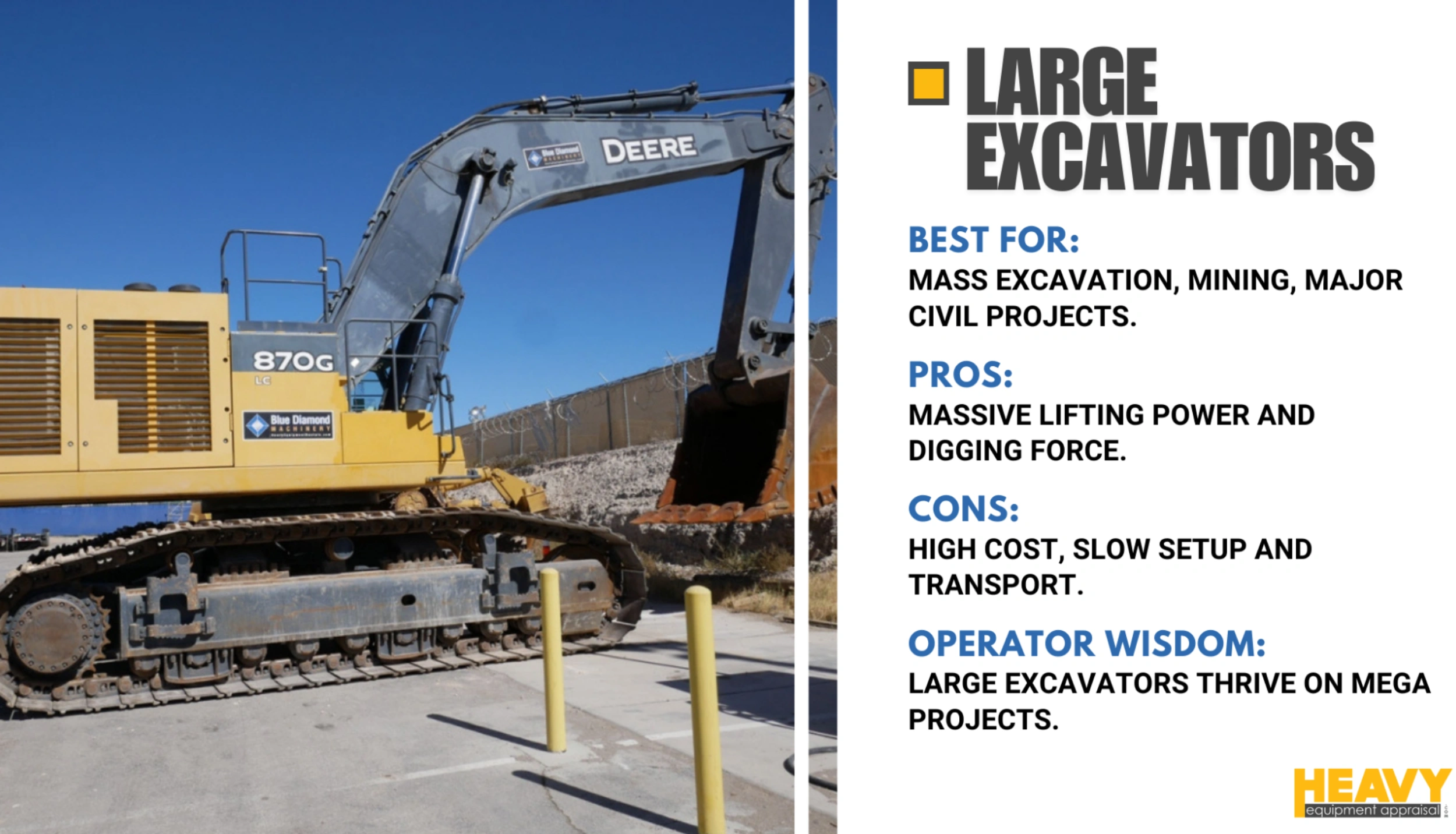
Large Excavators (over 45 metric tons): The heavy hitters deployed for major civil engineering projects, mining, and bulk earthmoving.
By Mobility
Crawler Excavators
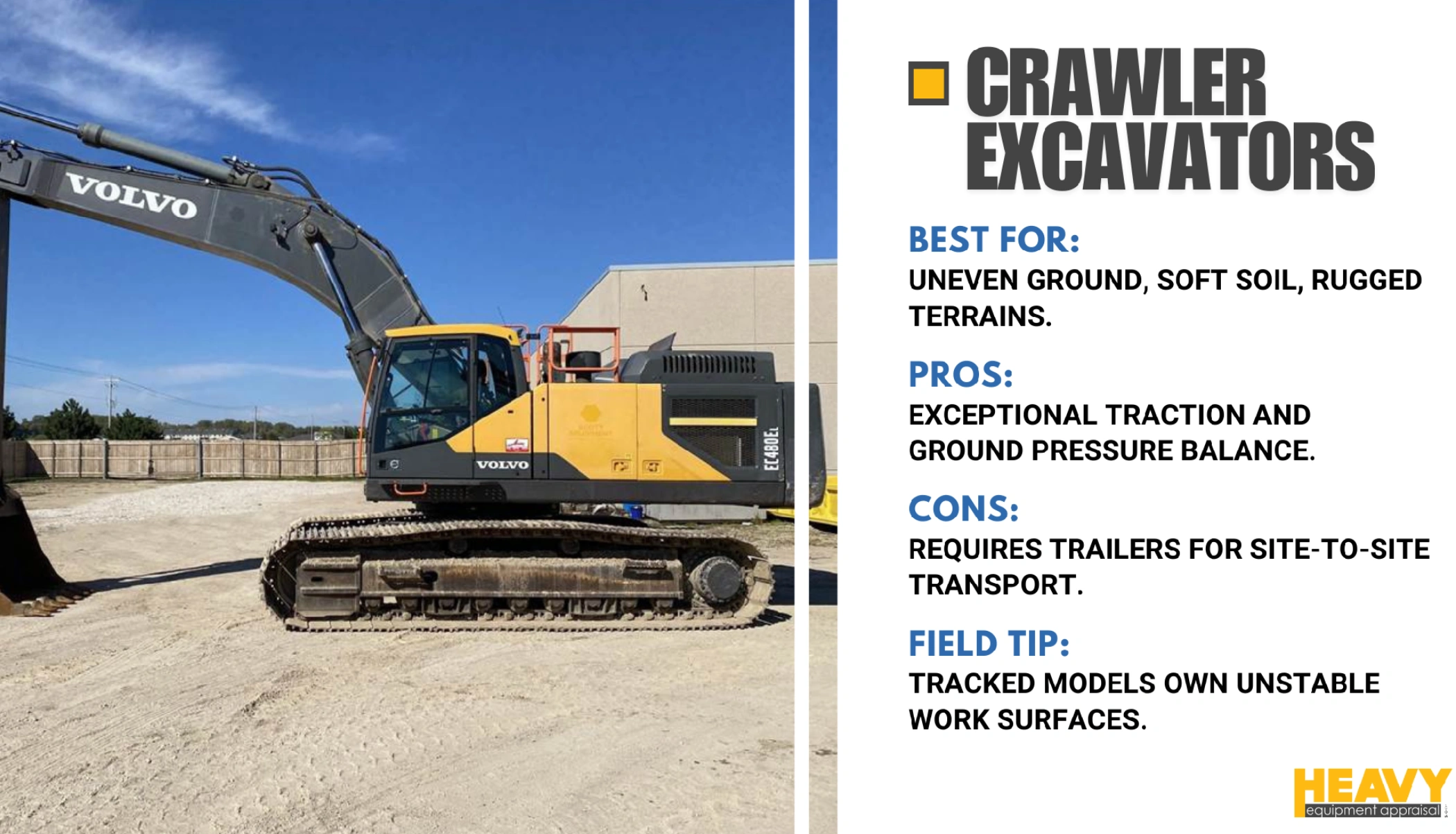
Running on tracks, these offer superior stability and traction on uneven ground but need to be transported between sites.
Wheeled Excavators
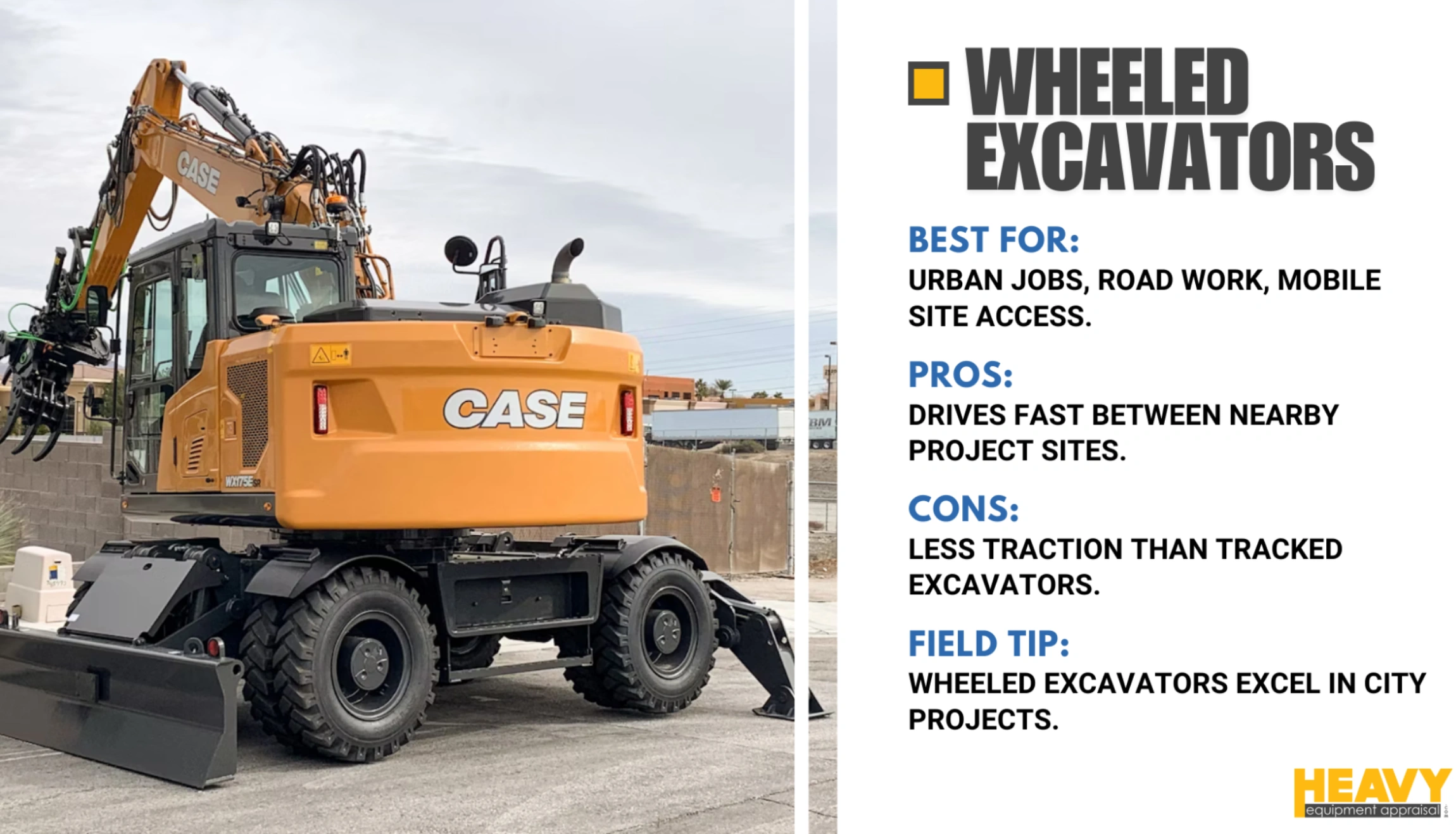
Equipped with rubber tires instead of tracks, these can drive between nearby sites and move much faster, making them ideal for road construction and utility work in urban environments.
Specialized Types
Beyond the standard models, there’s a whole universe of specialized excavators:
Long Reach Excavators
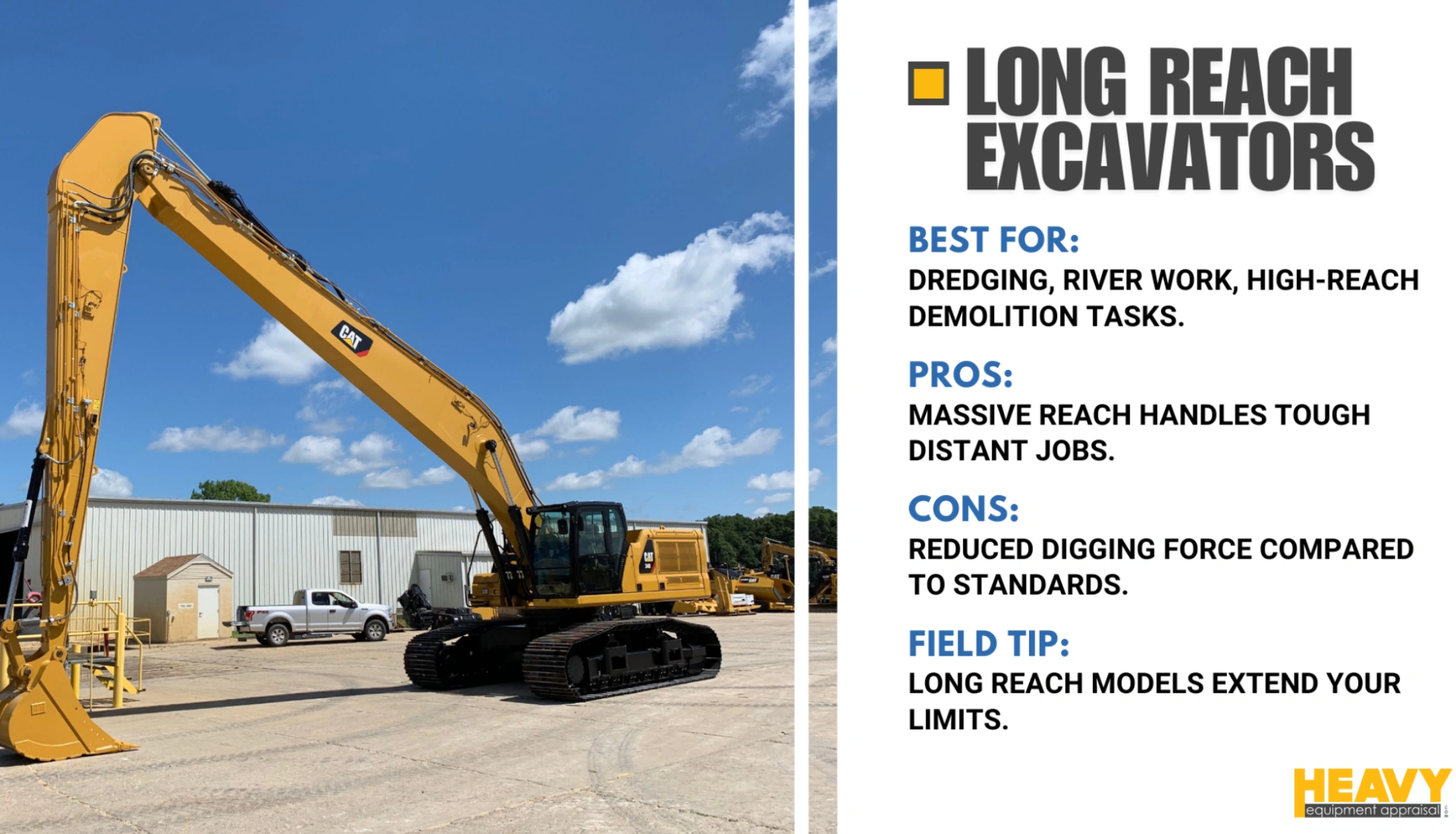
With extended booms and arms (reaching up to 100 feet in some cases), these are built for dredging, riverbank work, and high-reach demolition.
Dragline Excavators
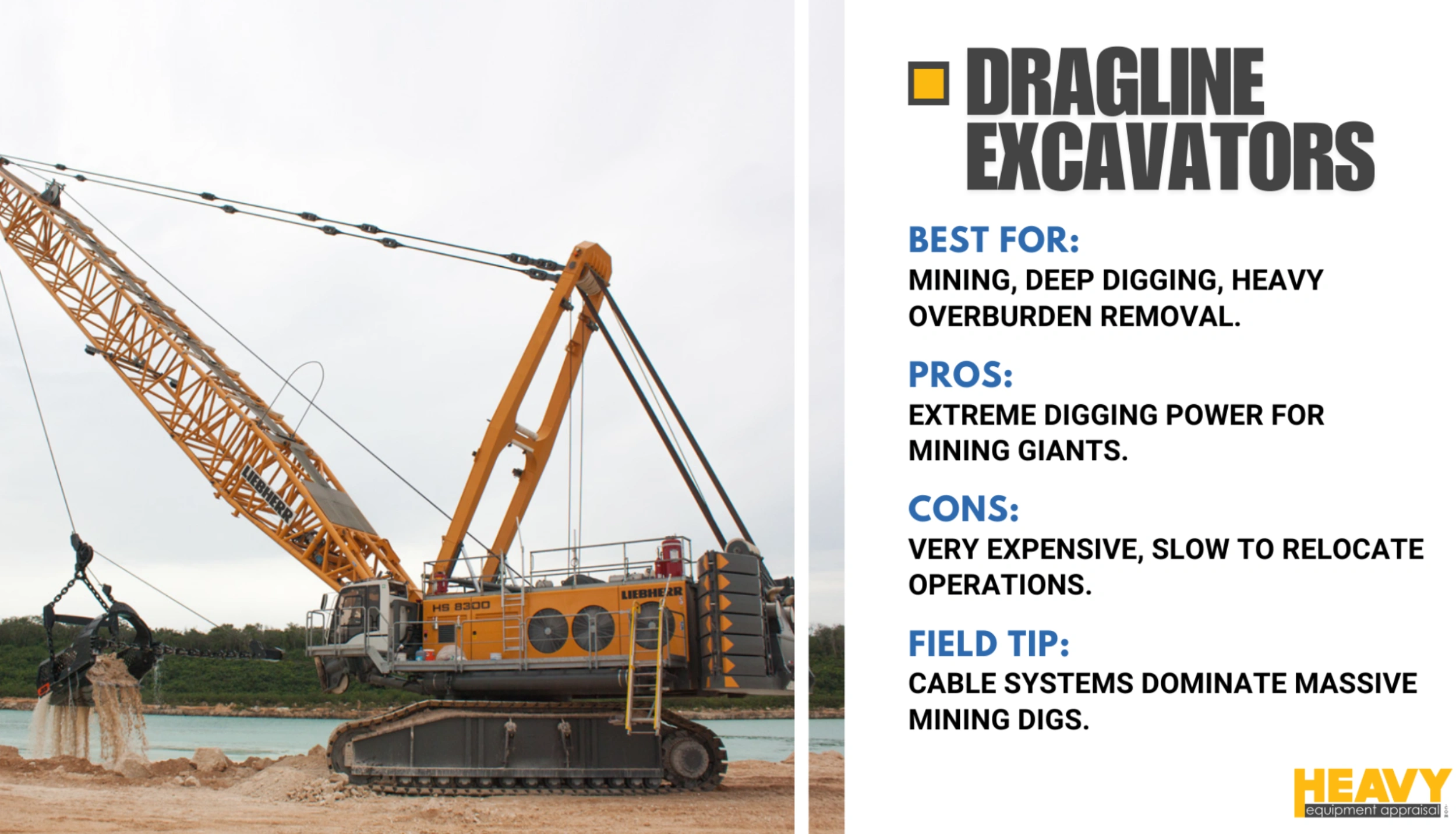
Massive machines using cables rather than hydraulics to control the bucket, primarily used in large-scale mining operations.
Suction (Vacuum) Excavators

These combine high-pressure water jets with powerful vacuum systems to safely excavate around sensitive underground utilities.
Hydraulic Shovels
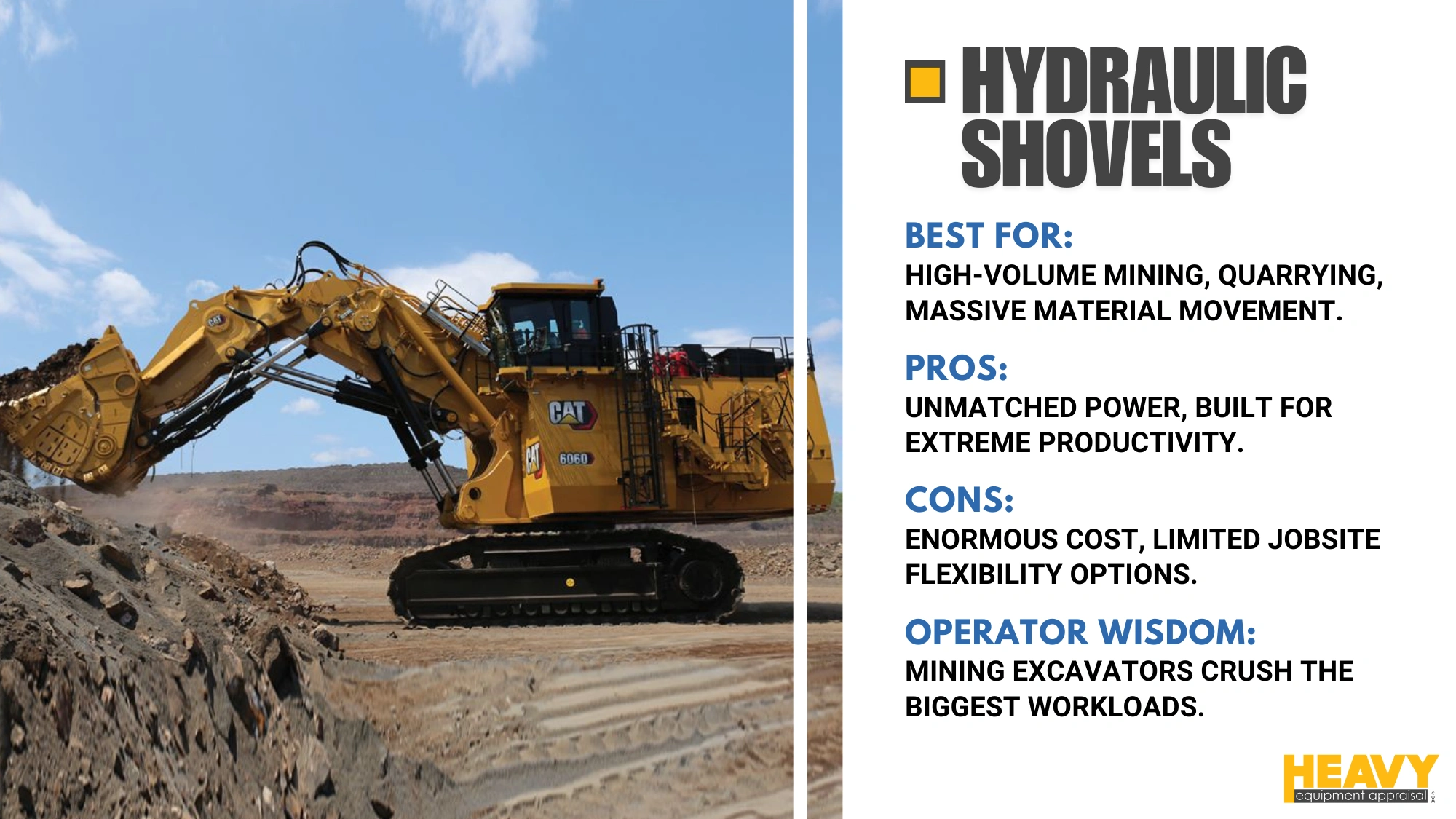
The upper echelon in size and power, primarily used in demanding mining operations.
Amphibious Excavators
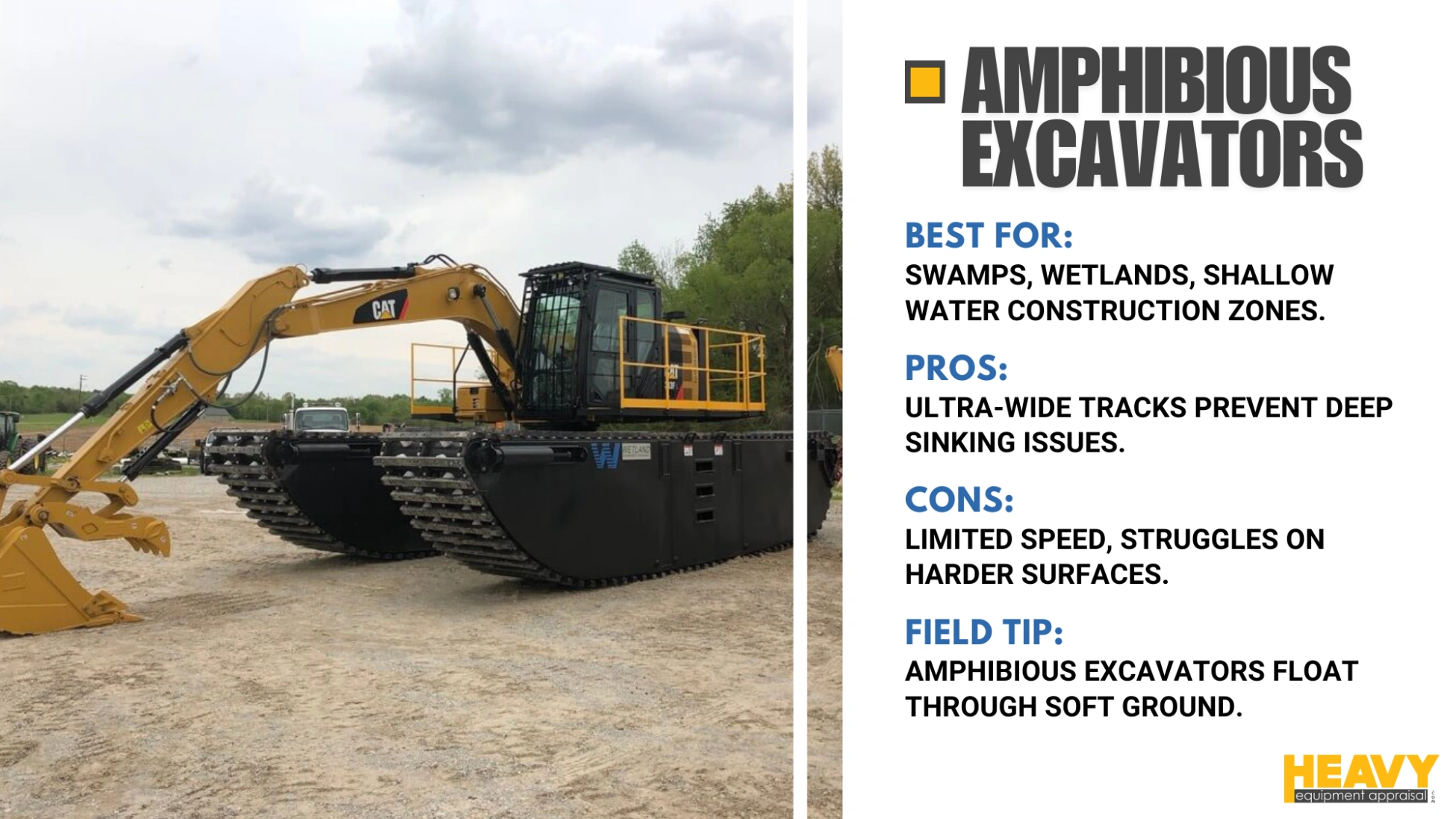
Specially designed to work in marshy terrain and shallow water with sealed pontoons and ultra-wide tracks.
And then there are the excavator cousins that aren’t true excavators but perform similar work:
- Backhoe Loaders: These Swiss Army knives combine a front loader bucket with a rear-mounted digging arm, though they typically have limited swing (180-200°) compared to a true excavator’s 360°.
- Skid Steers with Excavator Attachments: Highly maneuverable loaders that can be fitted with digging attachments for light excavation work.
The Numbers That Matter
When comparing excavators, you need to look beyond the glossy brochure specs. Here’s what actually impacts your productivity and bottom line:
Operating Weight isn’t just a transport concern – it’s the foundation of what your machine can handle. A heavier excavator gives you stability for lifting operations, but might sink in soft ground where a lighter machine floats. I’ve seen contractors overlook this basic spec only to discover their new purchase can’t safely lift the concrete vaults they handle daily.
Digging Performance defines your capabilities on site:
- Maximum depth is your vertical reach limit – that 20-ton standard excavator reaching down 25 feet makes quick work of deep utility trenches, while a mini’s 8-foot maximum restricts it to shallow applications.
- Ground-level reach determines your working radius without repositioning – critical when working around obstacles or along foundations.
- Dump height matters when loading trucks – nothing wastes time like not being able to clear the sidewall of your dump truck.
Power Metrics tell different parts of the performance story. Engine ratings (from 10 hp minis to 300+ hp standard models) matter, but the hydraulic system design determines how efficiently that power gets converted to work. And those load charts showing lifting capacity? They’re not suggestions – they’re physics.
Hydraulic System specifications separate adequate machines from exceptional ones:
- Flow rates determine operational speed
- Pressure ratings dictate force generation
- The combination shapes both breakout strength and fine control capability
Tail Swing configuration is a clear trade-off between stability and maneuverability. Zero tail swing machines can rotate within their track footprint – ideal for tight urban sites but often sacrificing some lifting capacity. Your typical working environment should dictate this choice more than any other factor.
Why Excavators Dominate Modern Job Sites

Excavators have transformed construction for reasons that go beyond simply moving dirt faster.
Their efficiency impact is staggering – a skilled operator can move more material in an hour than a crew could handle in a day. This compresses project timelines while reducing labor costs during a skilled labor shortage that shows no signs of easing.
What really separates excavators from simpler earthmoving equipment is their versatility:
- With quick-coupler systems, one machine transforms from trencher to material handler to demolition hammer in minutes
- The range of attachments – breakers, grapples, augers, compactors, thumbs – turns a single machine into a complete job site solution
- Most operators develop a personal connection with “their” machine precisely because it becomes an extension of their capabilities
Modern excavators deliver precision that would have seemed impossible twenty years ago. Hydraulic systems have evolved from the clunky on/off functionality of early models to proportional controls offering exceptional finesse. When you see an operator place a pipe in a trench with millimeter accuracy, you’re witnessing decades of hydraulic evolution.
Safety improvements have revolutionized hazardous work. Operators now work from protected cabs equipped with ROPS and FOPS, dramatically reducing workplace injuries while actually improving productivity. The ability to perform dangerous tasks from a safe position creates a better work environment and better results.
The industry’s push toward sustainability continues driving innovation – newer models deliver improved fuel efficiency with reduced emissions, while electric and hybrid options are emerging, particularly for indoor demolition or noise-restricted urban sites.
Industry Applications: Where Excavators Shine
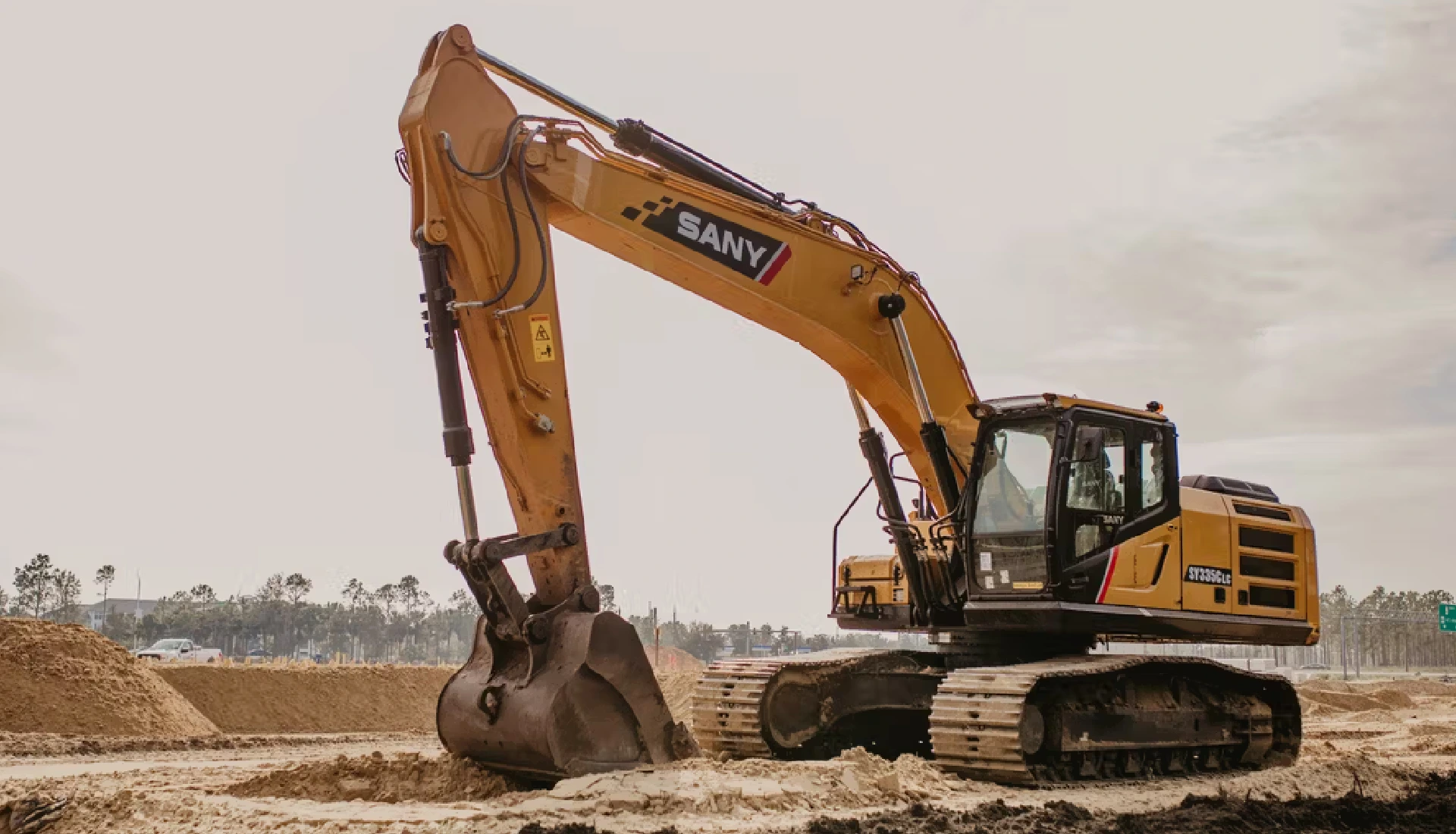
TIndustry Applications: Where Excavators Shine
Excavators have found their way into remarkably diverse applications, proving their adaptability far beyond basic earthmoving.
In construction, they form the backbone of practically every project’s early phases:
- Site preparation begins with clearing vegetation and debris
- Foundation excavation follows with precise depth control
- Utility trenching requires accuracy around existing services
- Material handling keeps other equipment supplied and productive
Roadwork leverages excavator precision for culvert installation, drainage systems, and breaking up deteriorated pavement. Wheeled excavators especially excel here, moving efficiently between work areas without damaging finished surfaces.
The landscaping industry has embraced mini excavators for transforming properties with minimal disruption. From tree planting to water features and hardscaping, these machines access tight spaces while their rubber tracks minimize lawn damage.
Demolition contractors rely on specialized attachments to systematically dismantle structures – shears cut steel, pulverizers process concrete, and grapples sort materials for recycling. Long-reach configurations allow operators to safely bring down structures while keeping a safe distance.
Mining operations deploy excavators at incredible scale, where moving massive volumes efficiently directly impacts profitability. Some mining excavators move 400+ cubic yards per hour, forming the production core of resource extraction worldwide.
Dredging and waterway maintenance require specialized amphibious excavators or long-reach configurations. Their ability to work from banks or while partially submerged gives them advantages over dedicated dredging equipment in many scenarios.
The forestry industry uses excavators with specialized attachments for land clearing, road building through difficult terrain, and log handling. Their mobility over rough ground makes them valuable for accessing remote logging areas.
Agriculture continues finding innovative applications beyond traditional earthmoving – from drainage tile installation to pond construction and material handling tasks that would overwhelm conventional farm equipment.
The key remains matching the right excavator to your primary tasks. Using a mini excavator for mass earthmoving is like showing up to frame a house with nothing but a finish nailer – technically possible, but painfully inefficient.
The Big Decision: Rent or Buy?
This isn’t just about upfront cost. The rent-versus-buy equation has multiple variables:
flowchart TD
A[Start: Need an Excavator] --> B{Annual Usage?}
B -->|Less than 175 hours| C[Consider Renting]
B -->|More than 175 hours| D{Consistent Job Types?}
C --> C1[Benefits: Low upfront cost]
C --> C2[Benefits: No maintenance responsibility]
C --> C3[Benefits: Access to latest models]
D -->|Yes, Similar Jobs| E[Consider Buying]
D -->|No, Varied Requirements| F[Consider Renting]
E --> E1[Benefits: Long-term cost savings]
E --> E2[Benefits: Guaranteed availability]
E --> E3[Benefits: Build asset equity]
F --> F1[Benefits: Right machine for each job]
F --> F2[Benefits: Flexibility for project needs]
G[Additional Factors] --> G1[Local Dealer Support]
G --> G2[Transport Logistics]
G --> G3[Storage Availability]
G --> G4[Maintenance Capability]
G --> G5[Cash Flow/Financing]That magic 175-hour annual threshold keeps coming up for good reason. Use your excavator more than that yearly, and ownership starts making financial sense. Below that, you’re basically paying a premium for a machine that spends most of its life collecting dust and depreciation.
Financial Considerations cut both ways:
- Your capital position matters more than most dealers will admit. Purchasing locks up significant cash that won’t be available for bidding new work or covering payroll gaps.
- Total Cost of Ownership goes far beyond the purchase price. Factor in financing, insurance, maintenance, major repairs, storage, and eventual disposal, offset by any residual value.
- Tax treatment varies significantly. Rental payments typically count as fully deductible operating expenses, while purchased equipment follows depreciation schedules (though Section 179 can completely change this equation).
From an operational standpoint, your usage pattern tells the real story:
- Consistent, similar projects favor ownership
- Diverse job requirements lean toward renting
- Seasonal workload fluctuations complicate the equation
One factor I’ve seen burn contractors repeatedly is equipment availability. Owning guarantees your machine is ready when you need it. I’ve watched companies lose valuable production days waiting for rental machines during spring construction booms when everyone suddenly wants the same equipment.
Logistical realities add another layer to consider:
- Maintenance responsibility falls entirely on your shoulders when you own
- Storage between jobs requires secure space (not a small consideration for larger machines)
- Transportation between sites becomes your headache, not the rental company’s
Here’s my take after watching hundreds of contractors make this decision: there’s no universal right answer. I’ve seen identical companies in the same market make opposite choices based on their growth plans, cash position, and risk tolerance. The key is being brutally honest about your utilization projections – optimism is expensive when it comes to iron.
Practical Selection Tips
Beyond the big-picture considerations, here are some practical factors that can make or break your excavator decision:
mindmap
root((Excavator Selection))
Project Requirements
:: Digging depth needs
:: Lifting capacity requirements
:: Material types to handle
:: Essential attachments
Site Constraints
:: Access width/height limits
:: Ground conditions
:: Proximity to structures
:: Operating space available
Logistics
:: Transport requirements
:: Legal weight restrictions
:: Road access to site
:: Movement between sites
Financial Factors
:: Total cost of ownership
:: Utilization rate (175hr threshold)
:: Rental vs. purchase analysis
:: Attachment costs
Operator Considerations
:: Experience level
:: Required training
:: Control preferences
:: Comfort features
Support Network
:: Dealer proximity
:: Parts availability
:: Maintenance capability
:: Service response timeSite access constraints should top your checklist. That perfectly-sized excavator is useless if it can’t reach the work area. I watched a landscaper deliver a mini to a high-end residential project, only to discover it couldn’t fit through the garden gate. Measure twice, rent once.
Transport logistics change dramatically at certain thresholds:
- Once you cross 8’6″ in width or specific weight limits, you’re in permit territory
- A seemingly minor size increase can mean needing a completely different trailer class
- Crossing state lines? Each jurisdiction has its own requirements
Dealer support quality often matters more than the brand name on the machine. That “great deal” from a dealer three states away loses its appeal fast when you need parts or service on a deadline. I’ve known contractors who switched brands solely based on dealer performance, even when they preferred the original manufacturer’s equipment.
Attachment compatibility is where theory meets practice. Your perfect excavator becomes significantly less perfect if it can’t properly power your hydraulic hammer or other attachments. Check the specs carefully:
- Flow rates (GPM/LPM) determine whether attachments run at full capacity
- Pressure ratings (PSI/bar) affect force output
- Control circuit configuration (single, double, proportional) directly impacts functionality
Operator comfort isn’t just about being nice to your people – it directly affects productivity during those 10-hour shifts. The small details matter: control layout, visibility, noise levels, HVAC performance, and even cup holder placement. One operator I know refused to run a particular brand because “the sun hits the monitor screen at the wrong angle every afternoon.” Petty? Maybe. But lost productivity is real money.
Match machine complexity to your operator capabilities. Today’s excavators range from basic mechanical controls to sophisticated computer-assisted systems that practically dig the trench for you. I’ve seen contractors invest in premium machines with advanced grade control systems their operators never used because they couldn’t (or wouldn’t) learn the technology.
Safety First, Last, and Always
No discussion of excavators is complete without emphasizing safety. These machines don’t care about your schedule pressures or profit margins – physics always wins.
Pre-operation procedures aren’t optional – they’re your first line of defense:
- Complete that walk-around inspection checking tracks, hydraulics, and safety systems
- Know what’s overhead, underground, and around you before the key turns
- Always call 811 before you dig – those few minutes prevent disasters
Trench safety deserves special attention. Soil fails without warning, and when it does, it kills fast. There’s a reason OSHA mandates protective systems in trenches deeper than 5 feet – cave-ins are among the most lethal construction accidents. I’ve heard too many stories that start with “we were only going to be in there for a minute.”
Load management isn’t just about maximum capacity – it’s about understanding stability in various positions:
- Know your machine’s lift chart for different boom positions and distances
- Never swing loads over personnel, regardless of how light they seem
- Understand that stability changes dramatically on slopes or soft ground
The “competent person” designation required by OSHA isn’t just bureaucratic jargon – it acknowledges that someone needs authority to stop work when conditions deteriorate. The best operators I know don’t hesitate to shut things down when something doesn’t look right, regardless of schedule pressure.
Communication protocols between operators and ground workers prevent the confusion that leads to accidents. Standardize hand signals, establish radio procedures, and make sure everyone understands exclusion zones around the working radius.
Value Retention: The Hidden Factor in Excavator Selection
Everyone fixates on dig depth and horsepower. After appraising thousands of machines, we’ve learned something different: configuration choices dramatically impact resale value.
Standard boom setups outperform specialized configurations by 15-20% at resale. Zero-tail-swing minis command premium prices consistently as urban work tightens. The 20-25 ton class depreciates slowest – about 45% in five years versus 55-60% for larger models.
Documentation trumps hours – a well-maintained 6,000-hour machine often appraises higher than a sketchy 3,200-hour unit. And those auxiliary hydraulic circuits? Pre-plumbed machines bring 8-12% more at auction even without the attachments themselves.
Before signing that purchase order, remember: the right excavator isn’t just about today’s dig – it’s about protecting your capital when it’s time to upgrade.
The Bottom Line
Excavator selection isn’t rocket science, but it’s also not something to take lightly. Get it right, and you’ll have a machine that boosts productivity and your bottom line. Get it wrong, and you’re looking at project delays, blown budgets, and safety headaches nobody needs.
Remember four things:
First, be ruthlessly realistic about your actual needs. The biggest machine isn’t always the best choice. I’ve seen plenty of contractors pay premium prices for features they never use.
Second, do the math on rent versus buy. If you’re putting 200+ hours a year on a machine doing similar work, ownership starts making sense. If not, let the rental yard handle the maintenance headaches.
Third, matching the machine to the site conditions matters more than brand loyalty. A perfectly-sized excavator that can access your work area beats a top-of-the-line machine that can’t fit through the gate.
Finally, never skimp on operator training or safety protocols. The best excavator in the world is only as good as the person in the seat and the systems around it.
As my old foreman used to say: “The perfect machine is the one that shows up when scheduled, does what you need without breaking, and costs less than it makes you.” Twenty years in this industry, and I haven’t heard it put better than that.
FAQ
What are different types of excavators?
There are several types of excavators, including crawler excavators, wheeled excavators, dragline excavators, suction excavators, skid steer excavators, and long-reach excavators. Each type is designed for specific tasks such as digging, lifting, demolition, or working in confined spaces. The choice of excavator depends on the project requirements and terrain.
What is the most common excavator?
The most common excavator is the crawler excavator. Crawler excavators use tracks for movement, making them suitable for a variety of construction and earthmoving projects due to their stability and versatility.
What is a 20 ton excavator?
A 20 ton excavator is a medium-sized hydraulic excavator that weighs approximately 20 metric tons. It is commonly used for general construction, digging, and material handling tasks, offering a balance between power and maneuverability.
What are small excavators called?
Small excavators are called mini excavators. Mini excavators typically weigh less than 6 metric tons and are used for tasks in tight or confined spaces, landscaping, and small-scale construction projects.

